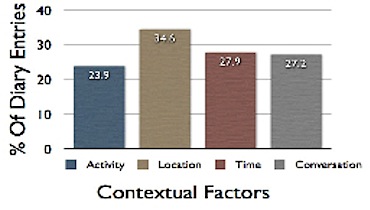T. Sohn, K. A. Li, W. G. Griswold, and J. D. Hollan, “A diary study of mobile information needs,” in CHI ’08: Proceeding of the twenty-sixth annual SIGCHI conference on Human factors in computing systems, (New York, NY, USA), pp. 433–442, ACM, 2008. [PDF]
———
This paper present a user study of how and why information needs arise when the user is on the go. The study reports a diary study of 20 people over the course of two weeks. They examined the information needs the participants had and the strategies that they used to address these needs.They also focused on the contextual factors thar prompted each need and influenced how it was addressed.
The authors used a snipped technique which consists in sending a short SMS to capture the gist of the moment and a web diary to provide more structured information around that moment. At the end of the day participants logged into the website to answer six questions about their snippet:
1. Where were you?
2. What were you doing?
3. What was your information need?
4. I addressed the need (At the time, Later, Not at all)
5. If you attempted to address the need, how did you do so? If you didn’t make an attempt, why didn’t you?
6. Could you have addressed your need by looking at your personal data (e.g., email, calendar, web browsing history, chat history, or other)
Through the 421 generated entries they were able to define the following taxonomy: trivia needs (18.5%), prompted by conversations or location-specific artifacts; directions (13.3%); friend info (7.6%); business hours, phone numbers (7.1%); personal schedule (6.4%); movie times (2.4%); and travel related.
Participants indicated that 72% of their reported information needs were prompted by some contextual factor. The contextual prompting can be classified in four broad categories: Activity, Location, Time, and Conversation. Activities reflect what the person was doing at the time. Location is the place where the person was at and includes any additional artifacts at that specific location. Time is the time when the need arose, and conversation is any phone or in-person conversation the participant was involved in at the time. Some diary entries were related to multiple aspects of context, such as having a conversation with someone about artifacts at the current location.

Figure 5. Percentage of different contextual factors that prompted information needs
The study reports qualitative observations of the multitude of ingenious methods that people use to satisfy their information needs. Many needs were postponed or not addressed because of attentional cost orcontextual factors. The lack of mobile internet was not the only inibitor. The authors conclude that the device’s sensitivity to the task at hand, situational context, and the links between personal and public data holds promise to ease mobile information access.







